Falling for Split Keyboards: Sofle ZMK, Lily58, and HolyKeebs Peripherals

Falling for Split Keyboards: Sofle ZMK, Lily58, and HolyKeebs Peripherals
Split keyboards changed how I work. My hands relax. My shoulders drop. And with ZMK on a Sofle and a QMK Lily58 nearby, I can mold input to the way my brain actually thinks.

The pink Sofle above runs my ZMK fork and has been my daily driver for over a year. Those OLED screens show layer status, WPM, and custom graphics that make me smile every time I glance down.
Why splits stuck
- Comfort first: Columnar stagger and proper tenting removed the tension I didn’t realize I’d normalized.
- Layers as language: Once you accept layers, your keyboard becomes an instrument. Text editing, nav, symbols, macros—everything falls into place.
- Peripherals matter: A HolyKeebs touchpad, trackball, or trackpoint keeps my mouse hand from wandering. The whole rig works with me, not against me.
About the Sofle ZMK fork
I maintain a fork of the Sofle ZMK firmware (especially for hdock/dongle pairings). It's translated, documented, and maintained so others can get up and running without falling into a weekend of yak‑shaving. Community work should feel welcoming.

The OLED screens aren't just pretty—they're functional. Layer indicators, WPM tracking, and even custom graphics make the typing experience more engaging and informative.

The Lily58 above features an integrated trackpad module - perfect for those moments when you need precise cursor control but don't want to reach for a mouse. It sits beautifully on my space-themed desk mat alongside other keyboards in my collection.
I believe a lot more people would love splits if the first‑run experience were better. That's what my fork tries to provide.
Tools that help
- ZMK + nice!nano/nrf52 boards
- QMK for Lily58 experiments
- VIA/Vial when I’m in the QMK world
- Portability: hdock/dongle pairs that “just connect”
Who should try splits?
Anyone who types a lot and feels the tension at the end of a day. With good defaults, the learning curve is a week—not months.
My layers, in practice
- Base: home‑row mods (caps as Ctrl/Esc via tap‑dance), symbols on a near layer
- Nav/Edit: HJKL arrows, word/line jumps, select/expand, common IDE chords
- Numbers: numpad cluster on the right with calc shortcuts
- Media/Mouse: volume, brightness, and a small cursor layer for laptop sessions
I change one thing at a time and live with it for a week. The map stabilizes because I'm practicing, not tinkering endlessly.

The RGB lighting isn't just for show—different colors help me identify layers at a glance. When I'm in my navigation layer, the keys glow blue. Symbols get a warm orange. It's functional eye candy that makes the whole experience more enjoyable.